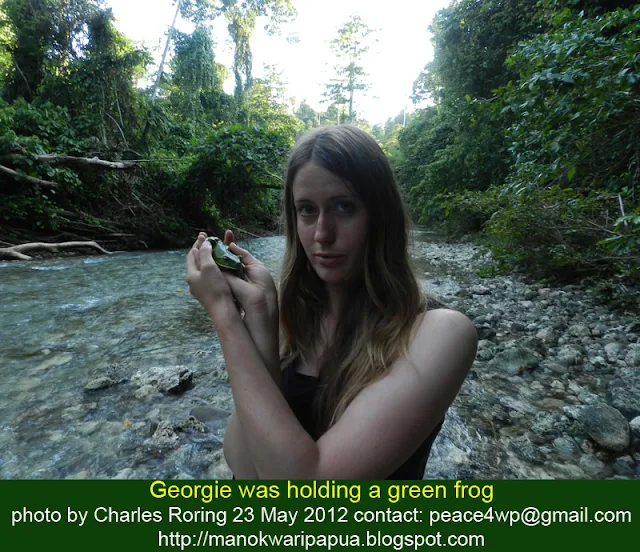I have just returned from birdwatching tour with two Swedish tourists in the lowland forest of Sorong regency. It was a full service birding tour in Klasow valley of West Papua. I picked them up from Waigo hotel in Sorong city and transferred them by a 4WD car to the valley. It took around 1.5 hours by car. We still need to walk through the forest to reach our birding hut located near Klabolo stream.
Birdwatching
 |
| Male Lesser Bird of Paradise |
One of the participants was a mature lady Inggrid Timle. She used a pair of Swift binoculars to see birds in distant trees. She said that she saw Lowland Peltops (
Peltops blainvillii), Papuan hornbill (
Rhyticeros plicatus), White-bellied Cuckoo-shrike (
Coracina papuensis) around the clearing area near our hut.
We also saw Glossy Swiftlet (
Collocalia esculenta), Moustached Tree-swift (
Hemiprocne mystacea), Dollarbird (
Eurystomus orientalis), Yellow-billed Kingfisher (
Halcyon torotoro), Lesser Birds of Paradise (
Paradisaea minor), Forest Kingfisher (
Halcyon macleayi), Rufous-bellied Kookaburra (
Dacelo gaudichaud), Western Black-capped Lory (
Lorius lory), Large Fig-Parrot (
Psittaculirostris desmarestii), Sulphur Crested Cockatoo (
Cacatua galerita), Black Lory (
Chalcopsitta atra), Pinon Imperial Pigeon (
Ducula pinon), Orange-bellied Fruit-Dove (
Ptilinopus iozonus), Pink-spotted Fruit-Dove (Ptilinopus perlatus), and a lot of other birds which I cannot mention in this post.
 |
| Pinon Imperial Pigeon in Klasow Valley |
Night Walk
In addition to birding, we did a short night walk in search of wallaby. It was a kind of Ground Kangaroo but had smaller body. We saw two wallabies in separate locations. To do the night walk, participants need to bring torch, wear trekking boots or sport shoes and apply insect repellent lotion on their exposed skins. There were also nocturnal animals such as Papuan Frogmouth (a kind of owl), Fruit Bats that we could find in the jungle. However, we felt that we need to sleep early for watching Lesser Birds of Paradise. That's why we returned to the village early.
Flowers and Butterfly
 |
| Flowers were blooming along the path of the village |
The Swedish visitors saw various colorful butterflies that fly around the clearing area of the lowland forest to collect nectar from flowers that were blooming everywhere. The villagers planted a lot of zinnia and other flowers in front of their jungle huts, church and along the path that connect their village and the main road. Some of them which I could identify were Blue Mountain Swallowtail (Papilio ulysses), Cruiser Butterfly (
Vindula arsinoe), Great Egg butterfly (
Hypolimnas bolina),
Taenaris catops, and birdwing butterfly (
Ornitopthera priamus).
 |
Jungle hut as our simple accommodation in
the forest of Klasow valley |
Accommodation
Our accommodation in the jungle was a simple hut made of wood and palm leaves as roof. But there was a toilet with clean water. We provide mattresses, mosquito net. Villagers work as cooks, local guides and porters during the jungle tour.
ITINERARY
Rainfores Tour in the forest Sorong regency
As a tour guide, I offer a full service rainforest tour in Klasow valley of Sorong regency. For 3 days/ 2 night tours, typical itinerary is usually described as follows:
Day 1 - I will pick you up in Sorong regency. By 4wd car, we will go to a lowland forest outside of the city. It will take around 1.5 hours. We will go hiking to the jungle hut. After taking a rest, we will walk around to find Magnificent Riflebird which is a species of bird of paradise. We will do general birding to watch Yellow-faced Myna, Golden Myna, Pinon Imperial Pigeon, Large Fig Parrot, Common Paradise Kingfisher, Yellow-billed Kingfisher, Oriental Dollarbird, and etc.
 |
| Magnificent Riflebird (Ptiloris magnificus) |
Day 2 - Early in the morning at 05.00, we will leave our hut for the forest to find Lesser Birds of Paradise, Twelve-wired Bird of Paradise as well as Red-breasted Paradise Kingfisher. We will return to the jungle hut again at noon. After taking a rest, we will do general birding to find Wompoo Fruit Dove, Pink-spotted Fruit Dove, Black-browed Triller, Black Lory, Grey-headed Goshawk, and etc.
Day 3 - Our target in the morning is King Bird of Paradise. We will also find other tropical birds as well including Lowland Peltop, Shining Flycatcher, Rufous-bellied Kookaburra, Helmetted Friarbird, Red-breasted Paradise Kingfisher, and a lot more. At 13.00, we will walk back to main road and return to the city by 4wd pick up car.
 |
| King Bird of Paradise |
 |
| Our birding hut in Klasow valley near Klabolo stream |
How to get there?
Fly from your country to Jakarta city (the capital of Indonesia)- Fly from Jakarta to Sorong city (daily flights between these cities are served by Garuda, Batik Air, Sriwijaya Air, Nam Air)
- I will meet you at the airport or at the hotel where you stay and arrange your trip into the jungle of Sorong regency.
Contact Person
Please, contact me, Charles Roring, using the contact form in the top right side of this blog or to my email: peace4wp@gmail.com
Also read:
















































